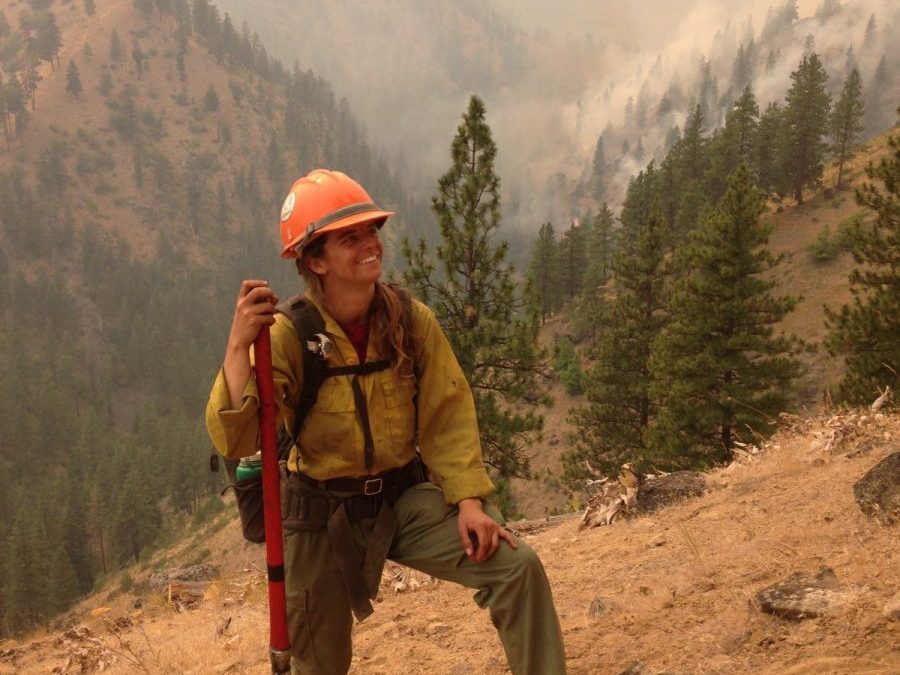Seattle at its smokiest Wednesday
What should we do about coming smoky summers? Ask a firefighter (Image: Amanda Monthei)
“Should Washington fight the Bolt Creek Fire to protect Seattle’s air?,” CHS asked seven days ago as we reported on the factors being considered by the Washington Department of Natural Resources in its command of the state’s firefighting resources. Those factors include communities, homes, and highways — but not air quality.
Now, after more smoke from newly surging incidents like the Loch Katrine fire poured into the region and pushed Seattle to some of the most dangerous air on earth this week, raindrops are finally starting to fall on Capitol Hill.
It is the right time to start getting ready for next summer — and the smoky summers that will follow.
A wildland firefighter who just came off the Bolt Creek Fire working as a Public Information Officer, Amanda Monthei has seven years experience with wildfires and says cities like Seattle need to prepare with new resources and clean air shelters in a new smokier future — fires on some of the nearest mountains and in wildlands only minutes away need the flames.
“We’re paying off a 100 year debt right now, if not more, to these forests that do need to burn,” Monthei says. “We have all this build-up and it’s very unlikely that we will just continue to exist in the way that we’ve existed for the last 100 years.”
On her podcast Life With Fire and on social media, Monthei is one of the few voices in Western Washington looking ahead and talking about what comes next. Government officials including Hilary Franz, Washington Commissioner of Public Lands, have focused their messages on the resources being used to contain but not extinguish the fires. Governor Jay Inslee’s office, meanwhile, is focused on its messages around global warming and climate change.
It is left to people like Monthei right now to explain what is happening on the ground where all the smoke is coming from. According to Monthei, the fires in the Western Cascades are significantly different than fires in California, Oregon, and even the other side of the mountains.
“It’s a different fuel type. And so what we expect from fires, what we see on the news of fires in California, isn’t necessarily what’s going to work over here….It’s just that in a steep rugged environment, you can’t place people.”
Because this recipe for wildfire isn’t going to change and next summer and the summer after are nearly guaranteed to bring more extremely smoky days, it is people like Monthei who have the earliest clear answers about what Seattle really needs to do about it.
Seattle has set up clean air shelters in past fire seasons for people experiencing homelessness or so people who don’t have access to air filters can find respite from the smoky days. Monthei knows better, more serious investment in infrastructure around supporting communities with clean air shelters is going to be necessary.
“Some sort of community building, whether that may be as a high school gym or something to that effect where they have that filtration in place,” she said. “Schools especially should have these filtration systems. I know it’s a huge problem that a lot of kids in the Sky Valley are missing school because of the AQI. So if they can, get those filtration systems in schools, and have that be a safe space for kids.”
Monthei says proper filtration systems, air purifiers, N-95 masks are all “good steps” for cities like to Seattle to start to consider planning for and says clean air shelters will be something we need to consider in places where people don’t have access to expensive filtration systems in their homes. “Support for vulnerable communities will be essential,” she said.
“We have to start thinking and acting like we live in a fire adapted ecosystem, because we do—despite that we’ve done a great job of hiding that fact through a century of fire suppression. Built up fuel, prolonged droughts and more people will inevitably result in more large fires.”
Monthei says the key is to “start planning for that future now, and consider learning more about how to build fire resilience in your community/neighborhood/life.”
She says Seattle should build around efforts like the Washington Fire Adapted Network and Firewise USA.
“I think the clean air shelters are what’s really going to be essential but (also) messaging about clean air shelters and ensuring that people that need them have that information about where they can go,” Monthei said.
Policy changes will also be needed to require employers to help protect workers from dangerous air.
“A lot of folks take days off and if that’s not the case, then it should be the case,” Monthei says about our future smoky summer. “Not only farm workers, but outdoor laborers. If possible, having those policy policy shifts in place to protect those folks from these really harmful days”.
Knowing more about the fires and why they sometimes need to burn is also something Seattle can start working on now.
The dangers of wildland firefighting is one place to start. Monthei tells CHS “that’s a huge part of why they chose this consumptive strategy.”
“Probably one of the bigger parts is that we simply cannot and nor will we put people into an area that has recently burned, more firefighters die by trees falling than anything else, certainly more than actual burnovers… so the less we can put people into those environments where they’re having to mitigate trees, because that’s very dangerous, the less the less potential there is for somebody to die or get severely injured in a really remote place that’s hard to provide care in,” Monthei said.
“They’re putting firefighters in places where it’s safe, or relatively safe…obviously firefighters do have a certain level of risk that they’re willing to deal with and work with. And they’re good at mitigating that risk in many environments, but up on the side of a mountain where they had to get flown in likely because there’s no foot access, there’s no road access. That’s just not a place that you want to put people, so that plays into the strategy as much as anything else does.”
With strategic air drops of water from huge tankers and firefighters limited to safer areas, consumptive strategies employed at Bolt Creek and Loch Katrine are long-burning and smoky. They’re also safer for wildland firefighters. And they’re better for our life amid the wildlands. Letting the fire burn down slowly to Highway 2, Monthei points out, meant that some ground vegetation burned but the larger vegetation that holds the slopes together did not.
“This strategy requires so much patience and people are understandably running out of it,” Monthei said via social media about the fires of fall 2022. “But it will pay off, I promise. The slope above the road has vegetation that will keep it together once the rain comes, and US 2 will undoubtedly have less mudslide closures this winter.”
The DNR says funding and resources are being used to both build up the state’s ability to more quickly suppress incidents while also doing more to make forests less susceptible to wildfire including controlled burning. Those investments are key to reducing “catastrophic fires” but also addressing concerns about smoke and air quality, DNR says.
But Monthei says the ingredients for more terribly smoky fire seasons will remain. “I don’t think it’s far off to assume that we will have similar climatic events, climatic conditions in the future that would contribute to similar fire spread,” Monthei said.
With two of years working as hotshot, time as a wildland firefighter with extensive specialized training in the most inhospitable environments, and three years working as a public information officer, Monthei has found a wider audience for her insights this fall. Her experience and knowledge is helping shed light on the type of fuel, location, and management that kept Seattle smoke-choked. And it has given her an opportunity to help point the region toward better plans to handle the smoky summers ahead. What she found, she says, was that “even if people don’t like what you’re telling them, this is really informative. It’s like they just need to know what’s happening and they can feel empowered,” Monthei said.
Monthei can be heard discussing wildland fires on her podcast, .
SUBSCRIBE AND KEEP CHS PAYWALL-FREE — $1/$5/$10
We love providing community news on CHS free for thousands of readers. What sustains the effort are voluntary subscriptions from paying supporters. If you are enjoying CHS, SUBSCRIBE HERE and help keep CHS available to all. Become a subscriber at $1/$5/$10 a month to help CHS provide community news with no paywall. You can also sign up for a one-time annual payment.
This content was originally published here.

